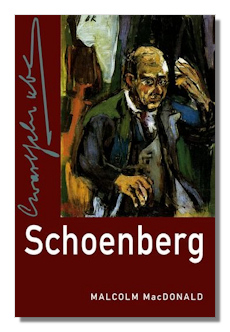
The Internet's Premier Classical Music Source
Related Links
-
Introduction
Acoustics
Ballet
Biographies
Chamber Music
Composers & Composition
Conducting
Criticism & Commentary
Discographies & CD Guides
Fiction
History
Humor
Illustrations & Photos
Instrumental
Lieder
Music Appreciation
Music Education
Music Industry
Music and the Mind
Opera
Orchestration
Reference Works
Scores
Thematic Indices
Theory & Analysis
Vocal Technique
Search Amazon
Recommended Links
Site News
 Book Review
Book Review
Schoenberg

Malcolm MacDonald
The Master Musicians Series
Oxford University Press, 2008
Revised 2nd Edition. Paperback, 366 pages 2016
ISBN-10: 0190469560
ISBN: 978-019-046956-6
MacDonald wrote his first edition of this book a generation ago, and his revision was first published in 2008, but this is the first paperback edition and evidently the only one now in print. It is a life and works approach, with heavy emphasis on the works. The author says in his preface that the actual new information is mostly in the biographical part, with amplified comments about the music. He is less polemical in the revision, though still a strong partisan of Schoenberg's music.
The heart of the book is a fifty page essay about Schoenberg's style, broken down into subtopics: Roots; Tonality; Philosophical Considerations; Total Chromaticism; 'Twelve Tones Related Only to One Another'; and Tonality Enlarged. Following Schoenberg, MacDonald strongly prefers the term "twelve note method" to "twelve tone music," though he occasionally refers to serialism. He follows Schoenberg's musical development from early influence from Brahms, Dvorak and Wagner through the greater use of chromaticism, to his maximal use of the twelve note method with occasional reversion to traditional tonalism in some works. His discussion of the Expressionist works such as Erwartung and Pierrot lunaire demonstrates just what the neoclassicist composers were to recoil against, though MacDonald does not discuss that at all. He does not even mention the controversy Schoenberg had with Stravinsky in the 1920s. Interestingly, MacDonald says of the Variations for Orchestra, Op. 31 (1928) that "this may be regarded as the point at which the twelve-note method…bursts into full flower." In contrast, an anonymous note on ArkivMusic says this work "is among a clutch of works composed from 1925-1928 in his neo-Classical style." To be sure, there is a difference between method and style; Schoenberg often used traditional forms.
For both Schoenberg and MacDonald, Schoenberg's compositional techniques are much less important than expressive content, in all this composer's periods. In this he was heir to the romantic tradition, definitely not a formalist. And he was not intent on following twelve-note rules, from which he would depart in the interest of what he wanted his music to sound like.
About half of the book is devoted to discussion of individual works, divided by genre and then by chronology. MacDonald writes eloquently, with facility, at length and in detail about the works, especially those he considers most important. He does not mention available or recommended recordings.
Copyright © 2016, R. James Tobin



















